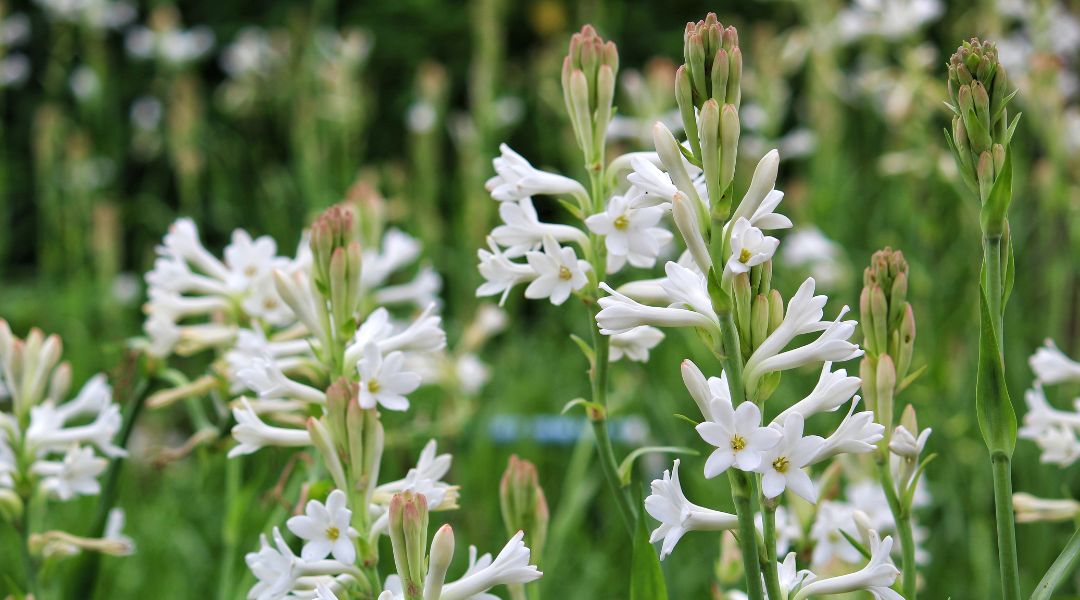Tuberose may be less common than some other tropical plants, but it produces one of the best smelling tropical flowers – and its scent is widely used. You may have been lucky enough to have worn one as a lei. Or maybe you’ve purchased a tuberose-scented candle, perfume, or a cream.
Most of us don’t have the luxury of space, time, or climate to grow these plants. But that doesn’t mean we can’t enjoy them! I’m going to talk about these flowers and how to bring their sweet perfumes into your life.
The botanical name is Agave amica (uh-GAH-vey uh-MEE-kuh). Yes, Agave! For those of you who are familiar with Agave it does seem odd to group a supposedly tropical flower into a family of succulents. This makes this scented blossom a relative of the century plant, yucca, dracaena and New Zealand flax.
Formerly the scientific (or botanical) name was Polianthes tuberosa (pah-lee-AN-theez too-ber-O-sa) and you may still see it labeled as such. You may also see the plant labeled and known by its Indian name Rajnigandha or Nishigandha. If you’re in Mexico Tuberose is called Nardo or Azucena.
The common name we use in California is Mexican Tuberose or just Tuberose. This common name is a touch misleading. This plant is not related to the rose, but it is a tuber. You can imagine a bulb-like structure planted underground and sending up 2’-3’ stocks with green grass-like leaves around stems with soft waxy white heavily and heavenly scented flowers. That would be your tuberose, which is often just labeled as a bulb.
The plant probably was a native to Mexico. Now it is not known to grow naturally in the wild anywhere which makes the tuberose a cultigen, or a plant known to grow only in cultivation. Now, we get most of the tuberoses from France and India.
Uses for Tuberose
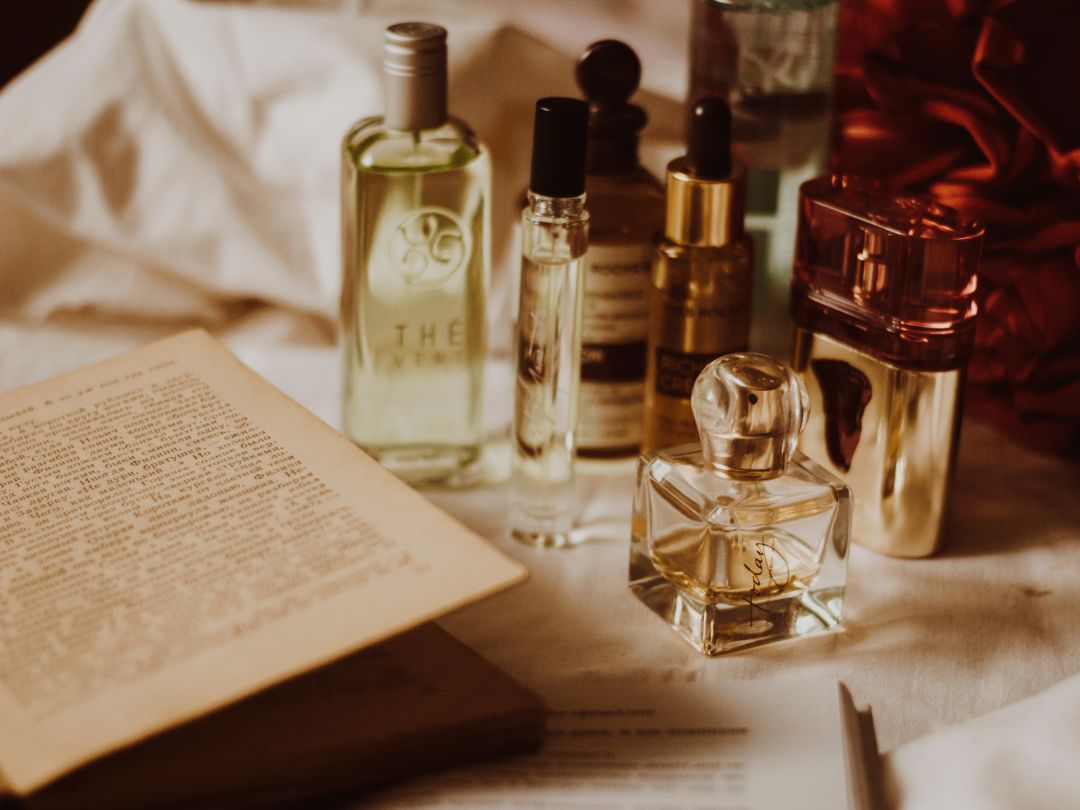
Tuberose is cultivated for perfume, essential oils and aroma compounds. And for its use as a cut flower. It’s also grown as an ornamental garden plant.
There’s a long history of cultivating this flower, dating back to pre-Columbian times. Originally from Mexico, the plant spread throughout the world in the 16th Century. It became a floral hit in Europe and was extremely popular at the French court.
The fragrant flowers of the Porcelain Trianon, which became the Grand Trianon at Versailles, were overflowing with fragrant hyacinth, jasmine, and tuberoses. Madame de La Vallière, one of Louis XIV’s mistresses, wore the tuberose in corsages and in her hair. Versailles, in the 17th century, became the birthplace for the profession of perfumer, using these flowers to produce fragrances and sachets as well as perfumed fans and gloves.
The long history of using tuberose in perfumes is still true today. Some describe the scent as soft and sweet while others call it light and spicy.
It was said that in Victorian times, the tuberose flower symbolized ‘dangerous pleasure’. In India, it’s known for its aphrodisiac powers and, get this, young women are advised not to breathe in its scent after dark lest they get some erotic urges.
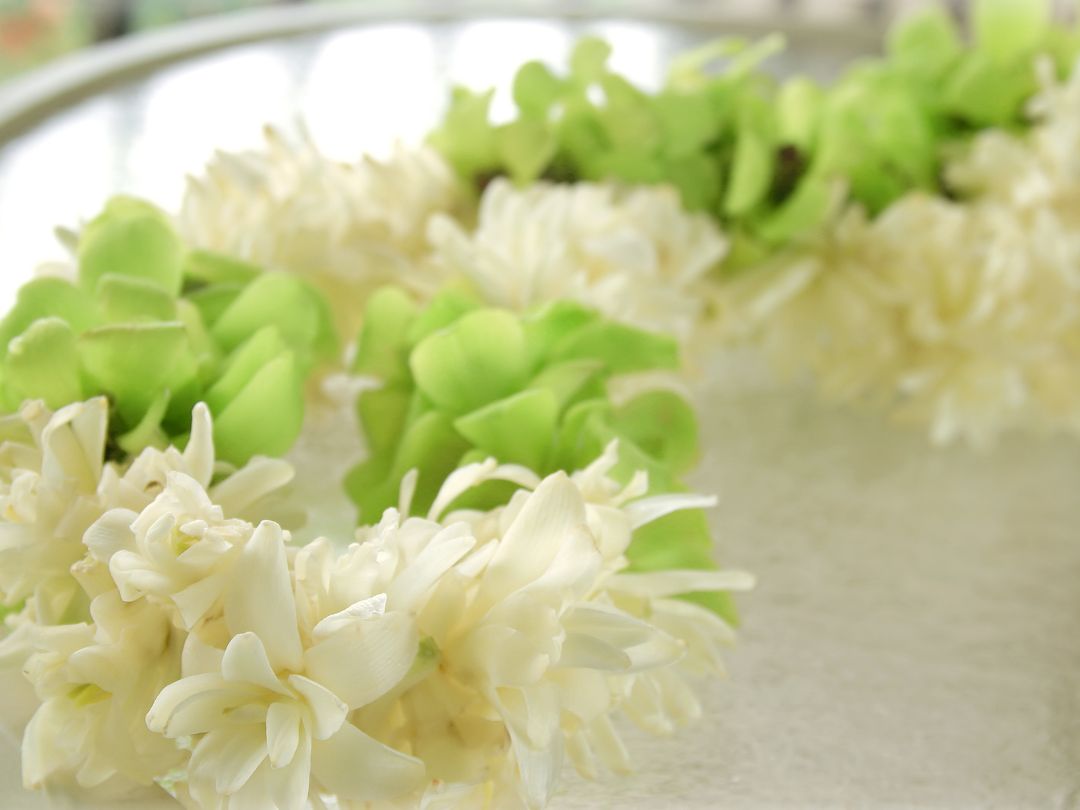
The Hawaiian name is kupaloke, and it’s a favored plant in making leis.
The tuberose is sometimes used on its own in a lei or paired with Dendrobium orchids, pikake, ti leaf, roses, or carnations. Some people find the traditional single strand of tuberose too thin and prefer a double strand. This is where you spear the flower on its side rather than through the middle of the base. This creates a much more lush and thick tuberose lei.
Tuberoses are great cut flowers in a bouquet or vase. The simple long stem with multiple blossoms of white with blush is an elegant upright addition to a floral arrangement, perfuming the entire room with its sweet scent. I keep it very simple and have floral arrangements of just tuberose which I will carry from room to room with me, refusing to leave the fragrance behind.
In a pot or in the ground, growing tuberose will add beauty and fragrance to your garden. This flower is beautiful in borders, attracts pollinators like moths and hummingbirds, and is, as we have mentioned, a highly fragrant cut flower for bouquets, vases, and leis!
Growing Tuberose
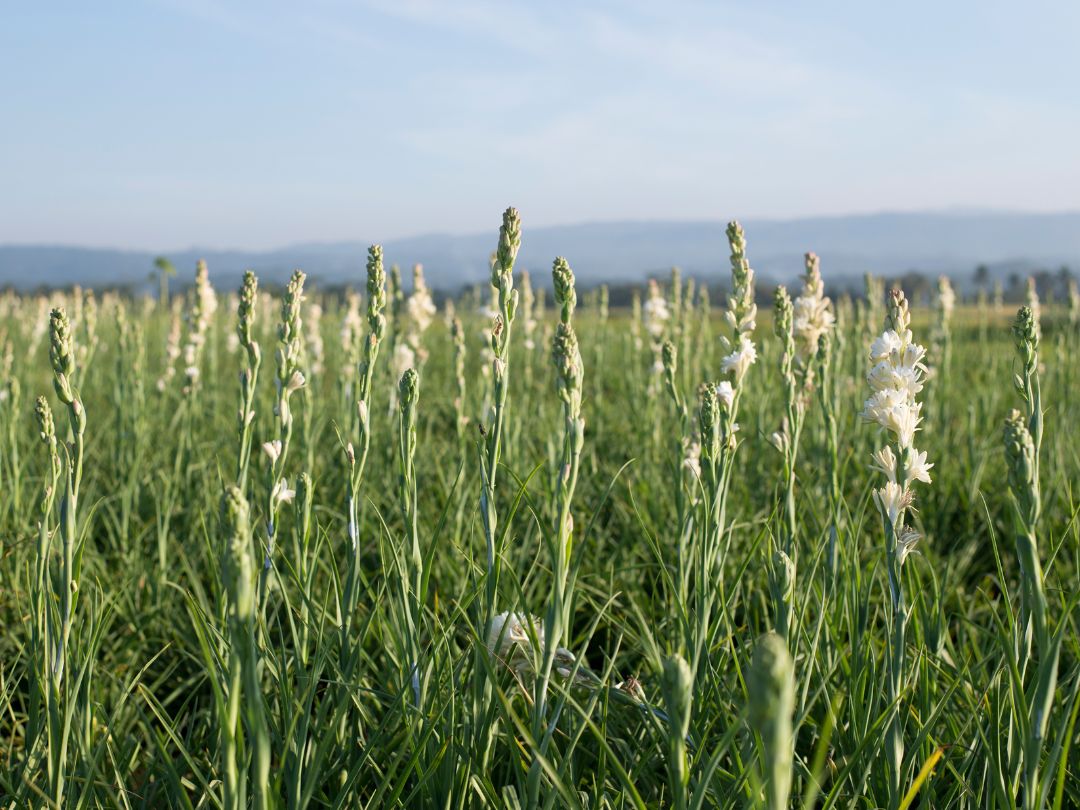
If you find yourself in zones 8-10 you can plant this tuber outside in a sunny well drained spot. You’ll want to do this in late winter or early spring, the tubers need about 4 months from planting to bloom and you will want to enjoy as much as those summer blooms as you can. You’ll clip back the leaves when they get yellow as the weather gets cool and into fall and in these warm clients leave the ‘bulbs”
If you’re in a colder climate you can start the tubers or bulbs in a greenhouse and then move the plant out after your last frost. You can plant in the ground or in a container. You’ll just want to make sure to dig the rhizome up and store in a cool, dry and dark place when the weather starts to get cold.
In the garden, the flower is hardy and drought tolerant. It is, after all, a member of the Agave family. While considered drought tolerant, the tuberose will look its best with a good inch of water once or twice a week. Be careful not to over water, tuberose don’t like to be in soggy soil and prefer it well drained. In the right situation, the plant should bloom all summer.
Luckily, cutting some of these blooms to enjoy indoors will encourage additional flower growth. The best time to cut the top of the shoot that holds more than a dozen blooms is when at least two of them are already open. The others will open slowly over the next few days. The average stem length of the tuberose length is 20 to 24 inches and the expected vase life is about five days.
Types of Tuberose
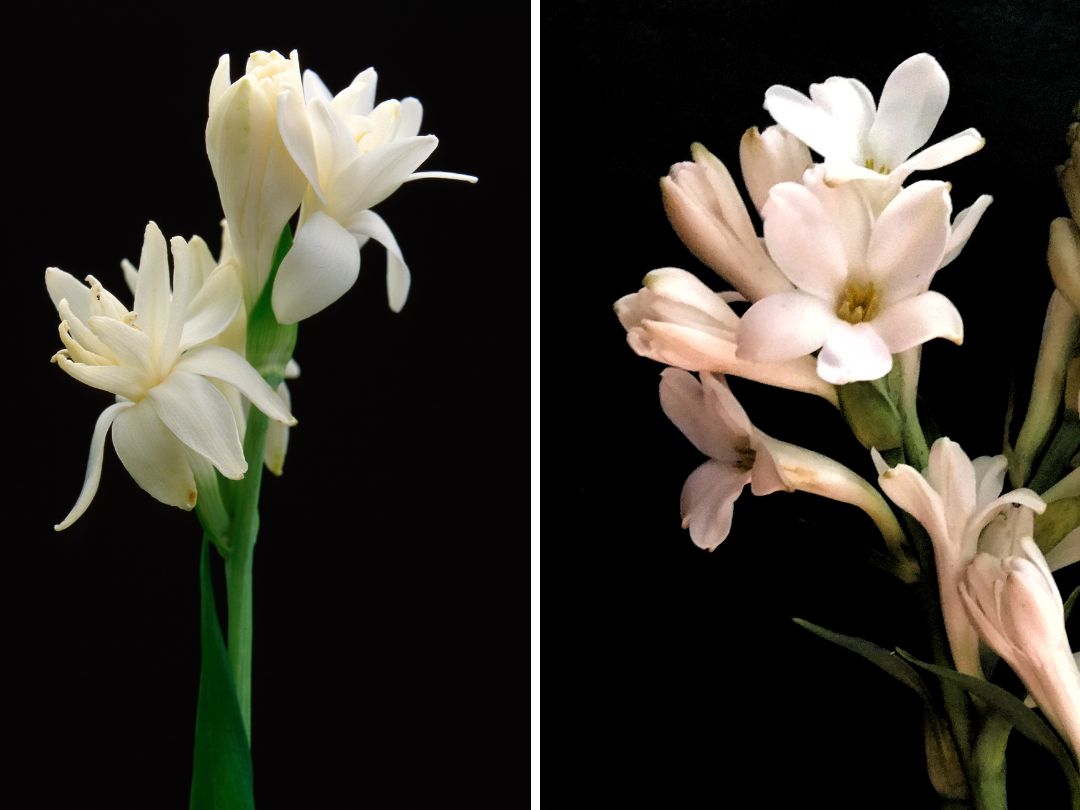
After you decide you want to plant a tuberose, you need to decide which cultivar to plant. Some plants produce a pink-toned flower while other have a yellow hue. Some have a smaller stem, and some have multiple rows of petals (these are labeled semi-double or double tuberose):
- Single: These are generally more fragrant than the double. Examples of single-type tuberose cultivars include Mexican Single, Calcutta Single, Hyderabad Single, Pune Local Single, and Phule Rajni.
- Double: These tuberose are used more as cut flower and garden displays. Examples of doubles include The Pearl, Arka Suvasini, Bidhan Rajani, Pune Local, and Hyderabad Double. Pink Sapphire (which has a pink flower) is an example of ‘colored double.’
The first place I go to source my plants are my local nurseries. If this fails, I start my online searches from Etsy and my favorite online suppliers. I would probably start, if I could find them, with the Mexican Single and The Pearl which is double.
Enjoying the Fragrance of Tuberose
The smell of tuberose, I have learned from The Perfume Society, is in perfumes such as Goutal Tubéreuse, Chanel Gardénia, Clive Christian C for Women, Dior Poison and J’Adore Dior, Diptyque Do Son, Floris Tuberose Frederic Malle Carnal Flower, Givenchy Amarige and Organza, Guerlain Jardins de Bagatelle and L’Artisan Parfumeur Tubéreuse.
Jo Malone has a Tuberose Angelica Cologne Intense that is described on their website as “a midnight garden filled with florets of hypnotic tuberose.” Diptyque Paris, and countless others, have tuberose scented candles. They describe this smell as “the twilight hour when tuberoses reveal their addictive sensuality. A heady perfume captured . . .” They also have tuberose scented room sprays and diffuser oils.
I often use the scent of tuberose while I’m in Hawaii. One of my favorite products right now is Lokelani Essential Tuberose Hydrosol. A hydrosol, or flower water, is produced by distilling fresh flowers, leaves, fruits, and other plant material, which, in this case is the tuberose. This process produces a very relaxing, simple, refreshing and mellow fragrance. Etsy Link
Happily, they sell this product at one of my favorite stores in Maui, Ho’olawa, but luckily you can also get it on Etsy. When I’m in Hawaii I keep this spray in the refrigerator and use it the moment I come in from the sun. I will probably get a stash of them to enjoy over the summer.
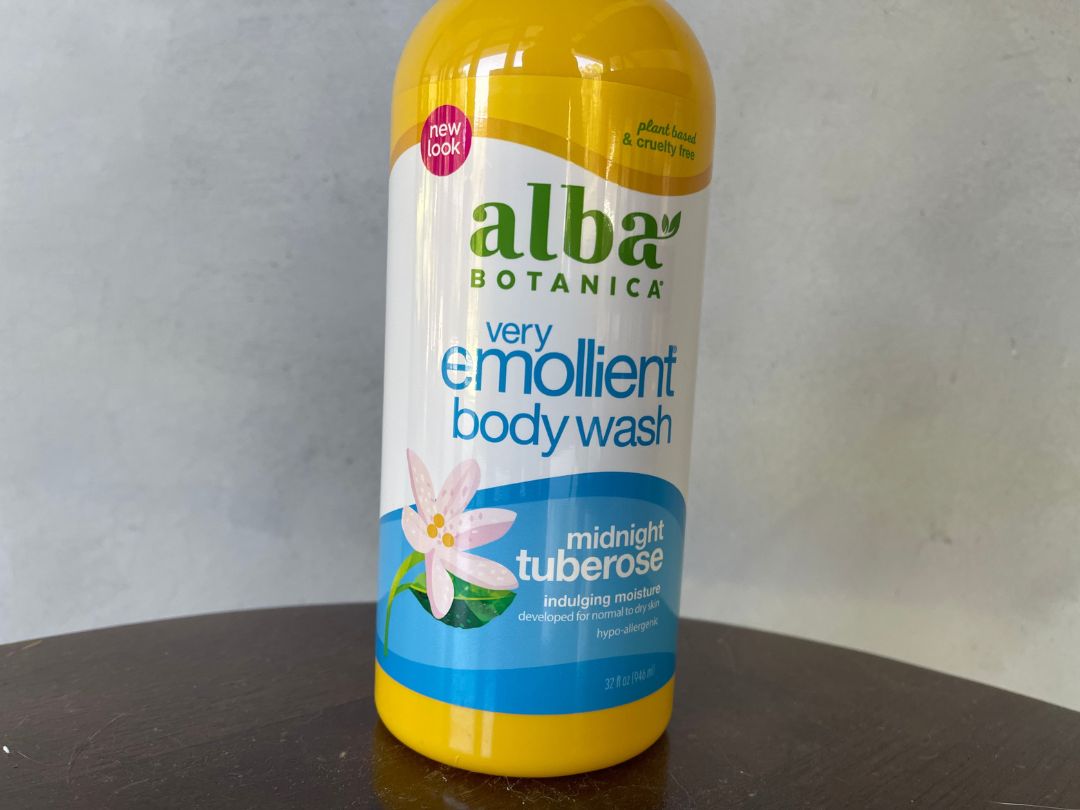
Being a big fan of the tuberose fragrance, I also bought some Alba Botanica tuberose body wash. I do love this smell, and the “midnight tuberose’ description is nice. This is a night blooming flower. But the description goes on to describe the tuberose scent as “taking your senses on a tour of an English garden.” I think I prefer the Victorian take!
We partner with select companies whose products and/or services we love. Some of the links on this page may be affiliate links. If you purchase an item using our affiliate link, we may receive a small commission (at no added cost to you). We appreciate your support.

